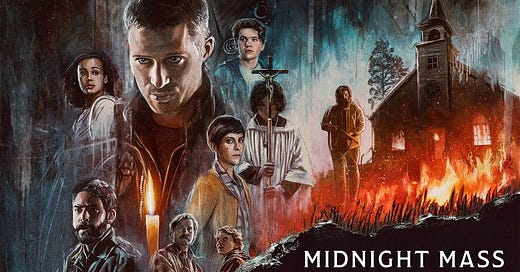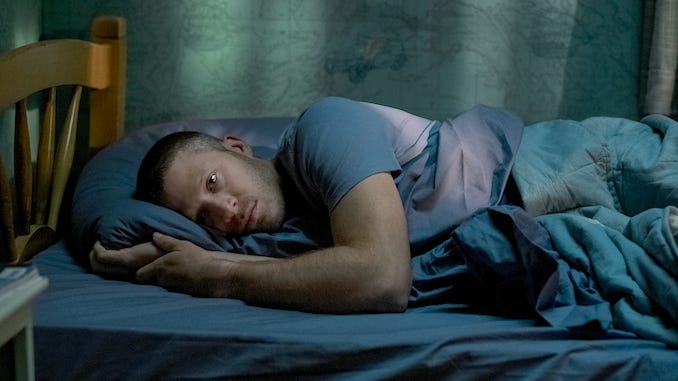Riley Flynn killed a girl. But all of Crockett Island is dying.
Midnight Mass1 begins in death. That is unavoidable. Those of you who have watched the series know the opening scene — a drunk-driving fatality at the hands of one of Midnight Mass’ central characters, Riley, who soon find himself haunted, broken, imprisoned; owning only family pictures and a Bible. Fast-forward to four-years later as Riley returns to his family in his hometown, Crockett Island; a small, isolated fishing island that is as nearly as dead as Riley’s victim.
On the same ferry which brought Riley home is Father Paul Hill, who we later discover is the new interim priest there to serve in lieu of the longtime, ailing priest, Monsignor Pruitt. Pruitt, now elderly and suffering with what seems like a form of dementia, was supposed to return home from a trip to the Holy Land, but Hill informs us that the elderly priest has taken ill and is recuperating on the mainland. In typical TV pilot fashion, we meet the entire cast of characters (see footnote). The show is off to the races.
On its surface, Midnight Mass is not the kind of show I would like. Midnight Mass, though, is about something that has always fascinated (and scared) me: Death.
Everyone and everything is dying. Riley kills a woman, killing his relationship with his father. Crockett Island is also dying, a process which started years before with an oil spill. And the economy of Crockett Island is dying. Longtime residents have boarded up their homes and left for more profitable opportunities elsewhere. “The people on this island…we used to be hundreds, now it’s dozens. This isn’t a community anymore, Honey, it’s a ghost,” says Annie Flynn to her returning son, Riley.
Even newness on Crockett Island feels like death. Riley, released from prison, might feel relief or newness of life, yet he doesn’t. Erin, pregnant with new life, doesn’t seem to feel enlivened and fresh. When we first meet her during an examination, her doctor finds spotting — nothing to worry about, but enough to tell you that all is not well.
Crockett Island is deteriorating. Joe is an alcoholic. The sheriff is grieving both the loss of his wife and career, and nearly everyone has some kind of ailment that makes them groan when rising to their feet after kneeling in prayer. Worst of all, Beverly Keane, the resident church-lady / tight-wad, does what tight-wads do; brings misery to everyone in her path. Believing herself righteous she lacks the self-awareness to know her practice of religion is harsh and graceless.
Everyone on Crockett Island is in some kind of pain. And that’s the point of Episode 1: Genesis.
A lot of us are in pain, too. And a core question in Midnight Mass concerns what lengths we’ll go to in order to alleviate that pain. Just like the book of Genesis, we are invited into the myriad pains humans endure and to ask the perennial question: What is God going to do about it? Midnight Mass, doesn’t posit sin as the root of suffering as does much of Christian theology. In fact, the pain belying Midnight Mass isn’t pain so much as it is disappointment. No one’s life on Crockett Island is as they would like it; even folks like Annie who would choose to live there nor Erin who returns to Crockett after a period of playing the Prodigal.
Where the biblical book of Genesis begins with life, with YHWH awakening breath in humankind, Midnight Mass’ Genesis begins in death and ends there are well. At the close of episode one, we see cats littered across the beach. This story, creator Mike Flanagan, wants us to know is a story of death and how we respond to death.
That’s why Midnight Mass doesn’t have to rely on jump scares and overly ominous music (pay attention to the music as Father Paul arrives on the ferry), because death itself is scary. Hear the words of the hymn, Abide With Me, which punctuates Episode One:
Abide with me, fast falls the eventide
The darkness deepens Lord, with me abide
When other helpers fail and comforts flee
Help of the helpless, oh, abide with me
We dislike even thinking about death and darkness. Think about Americans’ recent responses to wearing masks and local, state, and federal masks mandates. No one likes wearing masks, but not all of us protested at state capital buildings, caused fights on airlines, or participated in the myriad other fruitless protests to vocalize our displeasure at the compulsory mask wearing. Surely, there are plenty of reasons people dislike masks, but one — and one we don’t talk about enough — is the obvious one: they remind us of death. No one can wear a mask without being reacquainted with their mortality, their vulnerability. Perhaps that’s why women and men felt it necessary to arm themselves at state house to protest. When we feel vulnerable, we want to do something to make us feel strong.
Episode One asks: How are you facing death? What are you willing to do to avoid it?
Midnight Mass suggests we are willing to do the unthinkable.
This substack series is not a recap. I assume you have watched Midnight Mass at least once. Therefore: Spoilers. I will also not discuss items in chronological order, but write as one who has seen the entire series and will assume you have done the same. If not, stop reading. Start watching.






“When we feel vulnerable, we want to do something to make us feel strong”. As we move toward death we have 3 choices. 1. Fight death by getting angry, striking out at all things that remind us that we are going to die or shine light on our vulnerability as we age. 2. Maintain a stare of denial which can lead to hurt, sadness and anger again making us feel vulnerable. Or 3. Embrace our vulnerability and allow us to learn from it. Letting go is hard. Vulnerability is hard. And death is scary